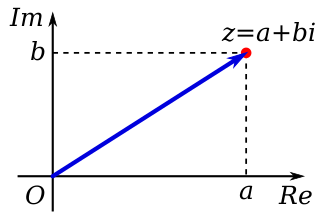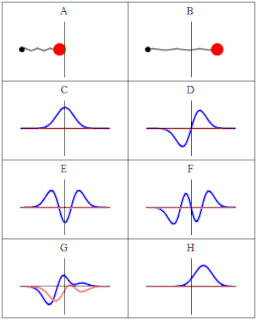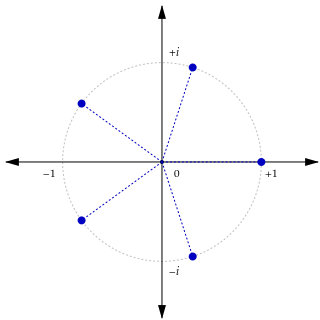The real numbers ω1, ω2, ... , ωn are said to be rationally dependent if there exist integers k1, k2, ... , kn, not all of which are zero, such that

If such integers do not exist, then the vectors are said to be rationally independent. This condition can be reformulated as follows: ω1, ω2, ... , ωn are rationally independent if the only n-tuple of integers k1, k2, ... , kn such that

is the trivial solution in which every ki is zero.
The real numbers form a vector space over the rational numbers, and this is equivalent to the usual definition of linear independence in this vector space.

In mathematics, a complex number is an element of a number system that contains the real numbers and a specific element denoted i, called the imaginary unit, and satisfying the equation i2 = −1. Moreover, every complex number can be expressed in the form a + bi, where a and b are real numbers. Because no real number satisfies the above equation, i was called an imaginary number by René Descartes. For the complex number a + bi, a is called the real part and b is called the imaginary part. The set of complex numbers is denoted by either of the symbols or C. Despite the historical nomenclature "imaginary", complex numbers are regarded in the mathematical sciences as just as "real" as the real numbers and are fundamental in many aspects of the scientific description of the natural world.

In mathematics, the discrete Fourier transform (DFT) converts a finite sequence of equally-spaced samples of a function into a same-length sequence of equally-spaced samples of the discrete-time Fourier transform (DTFT), which is a complex-valued function of frequency. The interval at which the DTFT is sampled is the reciprocal of the duration of the input sequence. An inverse DFT is a Fourier series, using the DTFT samples as coefficients of complex sinusoids at the corresponding DTFT frequencies. It has the same sample-values as the original input sequence. The DFT is therefore said to be a frequency domain representation of the original input sequence. If the original sequence spans all the non-zero values of a function, its DTFT is continuous, and the DFT provides discrete samples of one cycle. If the original sequence is one cycle of a periodic function, the DFT provides all the non-zero values of one DTFT cycle.

The quantum harmonic oscillator is the quantum-mechanical analog of the classical harmonic oscillator. Because an arbitrary smooth potential can usually be approximated as a harmonic potential at the vicinity of a stable equilibrium point, it is one of the most important model systems in quantum mechanics. Furthermore, it is one of the few quantum-mechanical systems for which an exact, analytical solution is known.

In mathematics and computer science, the floor function is the function that takes as input a real number x, and gives as output the greatest integer less than or equal to x, denoted floor(x) or ⌊x⌋. Similarly, the ceiling function maps x to the least integer greater than or equal to x, denoted ceil(x) or ⌈x⌉.

In mathematics, a root of unity, occasionally called a de Moivre number, is any complex number that yields 1 when raised to some positive integer power n. Roots of unity are used in many branches of mathematics, and are especially important in number theory, the theory of group characters, and the discrete Fourier transform.

The abc conjecture is a conjecture in number theory, first proposed by Oesterlé and Masser. It is stated in terms of three positive integers, a, b and c that are relatively prime and satisfy a + b = c. If d denotes the product of the distinct prime factors of abc, the conjecture essentially states that d is usually not much smaller than c. In other words: if a and b are composed from large powers of primes, then c is usually not divisible by large powers of primes. A number of famous conjectures and theorems in number theory would follow immediately from the abc conjecture or its versions. American mathematician Dorian Goldfeld described the abc conjecture as "The most important unsolved problem in Diophantine analysis".
In mathematics, an nth root of a number x is a number r which, when raised to the power n, yields x:

The square root of 2 is a positive real number that, when multiplied by itself, equals the number 2. It may be written in mathematics as or , and is an algebraic number. Technically, it should be called the principal square root of 2, to distinguish it from the negative number with the same property.
In number theory, the integer square root (isqrt) of a non-negative integer n is the non-negative integer m which is the greatest integer less than or equal to the square root of n,

Transcendental number theory is a branch of number theory that investigates transcendental numbers, in both qualitative and quantitative ways.

The rectangular function is defined as
In algebraic number theory, the narrow class group of a number field K is a refinement of the class group of K that takes into account some information about embeddings of K into the field of real numbers.
In numerical linear algebra, the method of successive over-relaxation (SOR) is a variant of the Gauss–Seidel method for solving a linear system of equations, resulting in faster convergence. A similar method can be used for any slowly converging iterative process.
Cubic reciprocity is a collection of theorems in elementary and algebraic number theory that state conditions under which the congruence x3 ≡ p (mod q) is solvable; the word "reciprocity" comes from the form of the main theorem, which states that if p and q are primary numbers in the ring of Eisenstein integers, both coprime to 3, the congruence x3 ≡ p is solvable if and only if x3 ≡ q is solvable.
In number theory, the Lagarias arithmetic derivative, or number derivative, is a function defined for integers, based on prime factorization, by analogy with the product rule for the derivative of a function that is used in mathematical analysis.

In mathematics, especially in the area of mathematical analysis known as dynamical systems theory, a linear flow on the torus is a flow on the n-dimensional torus

In fluid dynamics, the mild-slope equation describes the combined effects of diffraction and refraction for water waves propagating over bathymetry and due to lateral boundaries—like breakwaters and coastlines. It is an approximate model, deriving its name from being originally developed for wave propagation over mild slopes of the sea floor. The mild-slope equation is often used in coastal engineering to compute the wave-field changes near harbours and coasts.
The quantization of the electromagnetic field, means that an electromagnetic field consists of discrete energy parcels, photons. Photons are massless particles of definite energy, definite momentum, and definite spin.

In mathematics, an algebraic number field is an extension field of the field of rational numbers such that the field extension has finite degree . Thus is a field that contains and has finite dimension when considered as a vector space over .
In quantum computing, the quantum Fourier transform (QFT) is a linear transformation on quantum bits, and is the quantum analogue of the discrete Fourier transform. The quantum Fourier transform is a part of many quantum algorithms, notably Shor's algorithm for factoring and computing the discrete logarithm, the quantum phase estimation algorithm for estimating the eigenvalues of a unitary operator, and algorithms for the hidden subgroup problem. The quantum Fourier transform was discovered by Don Coppersmith.















